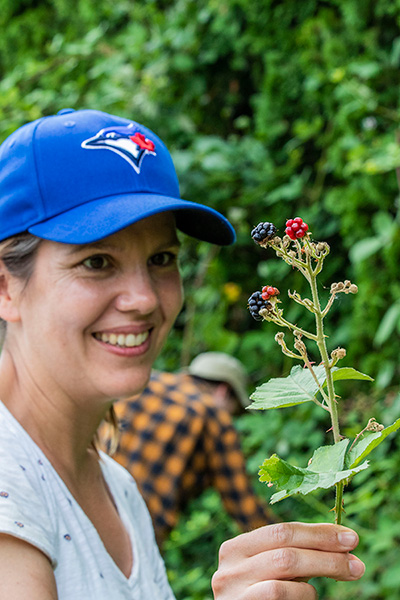Dr. Michelle Franklin’s fascination with bugs began in the forests and creeks of her youth. The buzzing wings and skittering legs that sent most people screaming always drew her in, even at a young age. Little did she know, however, that this childhood pastime would soon become a lifelong passion, leading to a career in small fruit entomology at Agriculture and Agri-Food Canada (AAFC). It was here that Michelle put her extensive bug knowledge to the test to fight against a new menace with an adorable name.
A sustainability champion

Michelle always wanted to pursue a career that would have a positive impact on the environment. During her undergrad, she saw the linkage between her two passions and began to see bugs from an environmental perspective. She recognized that finding green and sustainable ways to manage pests could have a big impact on the environment, which led to her harnessing microbial tools – viruses, bacteria, and fungi – to learn more about reducing the use of chemical pesticides.
What is biovigilance?
Biovigilance helps researchers forecast, anticipate, and respond to crop pest threats and challenges before extensive damage is done. It uses six cohesive steps (awareness, identification, assessment, understanding, mitigation, and appropriateness). Such an undertaking requires collaboration across disciplines – including taxonomy, entomology, geomatics, climatology, and knowledge transfer – as well as government departments, universities, and multiple industries.
As education led to career, Michelle joined AAFC’s Agassiz Research and Development Centre in 2020. She followed her passion for pests and applied what she learned regarding sustainable pest management. She quickly realized that a big part of the pest puzzle was properly predicting their behaviours and started using proactive prevention methods based on the concept of “biovigilance.” Unlike traditional pest management, “biovigilance means taking a holistic approach,” Michelle says. “It helps us respond rapidly and flexibly to pest threats.”
Considering the array of factors at play, such as increased trade, globalization, and new insect behaviours, a complete and rounded approach is necessary to help with the ever increasing complexity of pest management. The small fruit industry was particularly affected by the pest pinch, so Michelle’s work in developing biovigilance guidelines may prove vital for its growth and stability.
And timely—Michelle soon had to put her biovigilance knowledge to the test and face a new adversary: the strawberry blossom weevil.
A new threat to berries

Native to Europe, Asia, and parts of North Africa, the first recorded sighting of the strawberry blossom weevil in North America was in Abbotsford, British Columbia in 2019. By 2020, it was already found in many municipalities in the Fraser Valley and Metro Vancouver.
Small and long-nosed, the weevil lays its eggs inside a closed fruit bud, then chews away at the stock to prevent the bud from opening while its larvae develops. This results in fruit loss and a loss in income for growers. And despite its name, the strawberry blossom weevil is also a direct threat to raspberries, blackberries, and other plants.
While many saw this new invasive species as a daunting challenge, Michelle saw it as an opportunity.
Focusing on the first four steps in the biovigilance approach (awareness, identification, assessment, and understanding), she brought together a multi-disciplinary team of 50 experts from inside and outside the department to work on the project. They started by learning everything they could about the strawberry blossom weevil, from tracking its distribution, host plants and natural enemies to ensuring the correct identification. Other questions they were looking to answer related to the environmental and economic impacts of this pest, such as how much damage would be caused to crops, and how that would affect a growers’ bottom line.
The data they collected will help inform strategies to mitigate and manage the strawberry blossom weevil and will culminate in a surveillance app that could be modified to monitor future pest threats.
Everything seemed to be going according to plan for Michelle and her team, until a strange new guest showed up in their lab one day.
An unexpected ally
Michelle noticed a beautiful metallic green insect had emerged from one of the damaged fruit buds, quite different from the small black weevil she’d been studying. Known as a parasitoid (an organism that develops on or within another organism), this insect appeared to lays its own eggs inside the same bud where the strawberry blossom weevil was developing. This new green insect then fed on the weevil’s larvae, resulting in the larvae’s death. More than 150 of these parasitoids emerged from the damaged buds that had been collected in 2020, which was strange since the strawberry blossom weevil was only recently established in the region.
Not that Michelle’s complaining.
As she notes, “It was quite a surprising discovery, but it’s great because it gives some promise that maybe there will be a natural enemy to help.” This little green natural enemy could help control pest populations by reducing reliance on pesticides — a win for growers and the environment!
Currently, little is known about the parasitoid, which is thought to be undescribed (meaning it has not been formally named). Further research is underway in collaboration with the Canadian National Collection of Insects, Arachnids and Nematodes to identify what it is, where it came from, and its potential to help control strawberry blossom weevil populations.
Seeing her childhood fascination with bugs turn into a career that supports the environment has been very fulfilling for Michelle. “As the complexity of pest threats increases, so does the need for biovigilance,” she says. “In the end, we want to provide Canadian growers with tools and solutions to deal with pest threats self-sufficiently.”
Get more Agri-info
- Want more stories like this? Explore what else Agri-info has to offer.
- Interested in reporting on this story? Contact AAFC Media Relations at aafc.mediarelations-relationsmedias.aac@agr.gc.ca to arrange an interview with one of our experts.